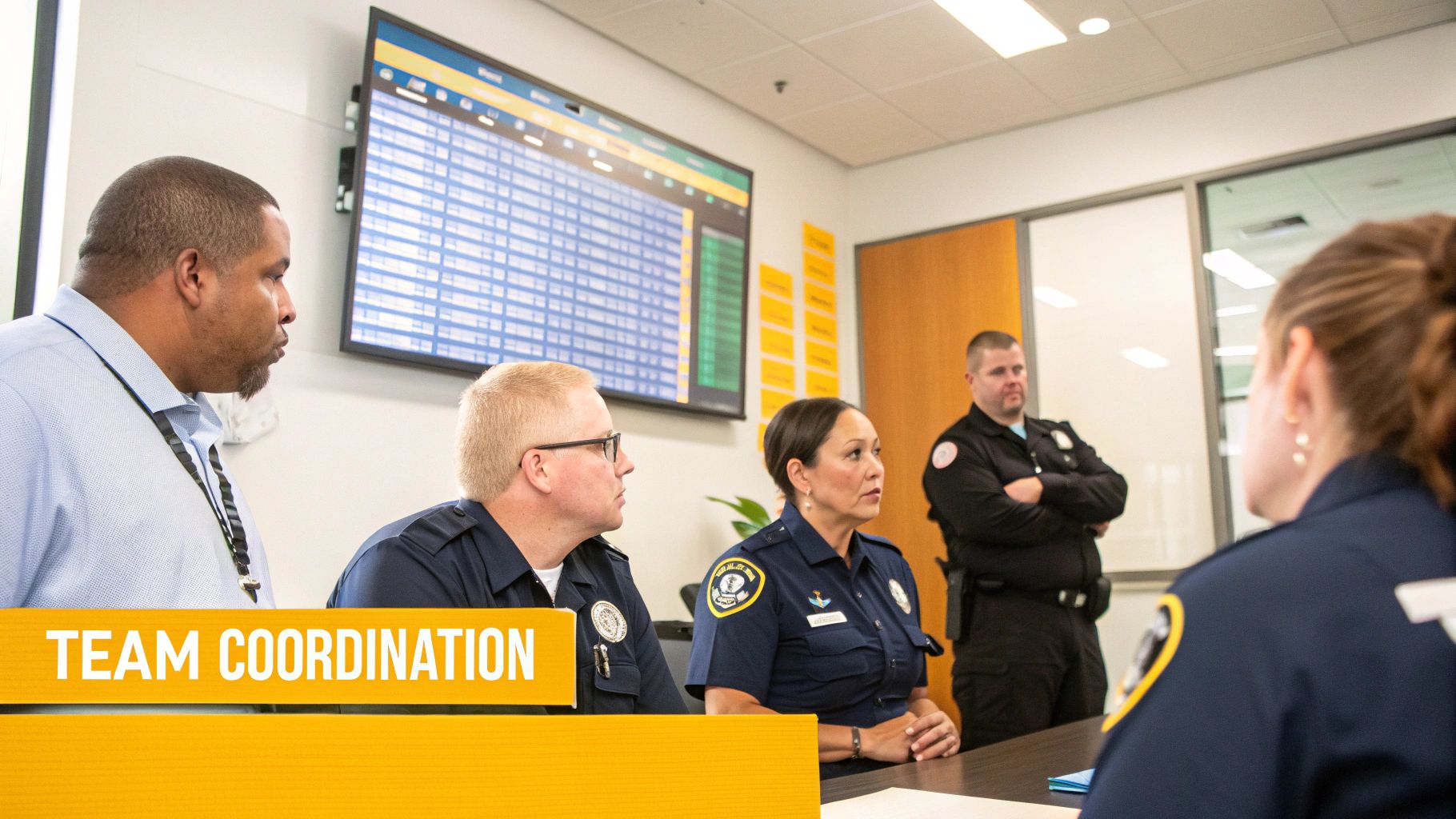From our resource library for organizational scheduling and management.
Police Officer Scheduling: A Complete Guide to Modern Shift Management

Understanding Modern Police Officer Scheduling Patterns

Police departments face real challenges with their current scheduling approaches. Officers often feel exhausted and unmotivated under rigid scheduling systems that don't account for their needs. When officers are overworked and stressed, it directly affects how well they can serve and protect their communities. That's why departments are moving toward scheduling that better balances 24/7 coverage with officer wellbeing.
Crime doesn't follow a fixed schedule. Some neighborhoods see more activity at night, while others peak during the day. Major events, festivals, and seasonal changes mean departments need different staffing levels throughout the year. Smart scheduling means understanding these patterns and planning accordingly. Let's look at how departments are using real data to make better scheduling decisions.
Utilizing Data For Effective Scheduling
Numbers tell an important story when it comes to police staffing. By looking at past crime reports, emergency calls, and patrol data, departments can spot trends and predict busy periods. This helps them schedule the right number of officers at the right times. When departments study their data carefully, they can fill coverage gaps and make sure shifts align with when communities need police presence most.
Balancing Officer Well-being and Coverage Needs
Police work takes a toll on officers. Most full-time officers work 40 hours each week, with shifts ranging from 8 to 12 hours. Some departments have switched to 10-hour shifts to give officers more recovery time between workdays. For more details about police working hours, check out InTime's article on police officer work schedules. Finding this balance between coverage and rest is key to keeping officers healthy and alert on the job.
Exploring Innovative Scheduling Models
Police departments are testing new ways to schedule their officers that work better for everyone. Here are some approaches gaining popularity:
- Compressed Work Schedules: Instead of five 8-hour days, officers might work four 10-hour shifts or three 12-hour shifts weekly. This gives them longer breaks to rest and spend time with family.
- Rotating Shifts: Departments are getting smarter about how they rotate shifts, using data to minimize disruption to officers' sleep and personal time.
- Flexible Scheduling: Some departments let officers trade shifts or pick preferred time slots, which helps improve job satisfaction.
These new scheduling approaches show how departments can meet their coverage needs while taking care of their officers. When officers are well-rested and satisfied with their schedules, they serve their communities better. Good scheduling isn't just about filling time slots - it's about creating a system that works for both the police force and the public they protect.
Maximizing Performance Through Compressed Work Schedules

Police departments are looking beyond traditional scheduling methods to better serve their communities and support their officers. Compressed work schedules (CWWs) have emerged as an effective solution that focuses on getting the most value from each shift rather than just filling time slots. These schedules can help departments reduce costs while giving officers a better work experience.
Benefits of Compressed Work Schedules
Officers who work compressed schedules often find they have more quality time away from work. Having additional full days off means they can spend time with family, take care of personal needs, or simply recharge - all essential for maintaining good mental health. The longer individual shifts can also help officers stay more focused on cases and patrols since they have fewer start/stop transitions in their work week.
For police departments, CWWs directly impact the bottom line by reducing overtime costs. When shifts are planned effectively, departments need less overtime coverage to maintain proper staffing levels. Better-rested officers also tend to perform their duties more effectively. As a result, many departments find that compressed schedules help them keep experienced officers on the force longer.
Implementing Compressed Work Schedules Effectively
The two most common CWW formats are the 4/10 schedule (four 10-hour shifts weekly) and the 3/12 schedule (three 12-hour shifts weekly). Each format works better for different roles - patrol officers might benefit more from 4/10s, while investigative units could be more productive with 3/12s. The key is matching the schedule to the specific needs of each unit.
Making the switch to compressed schedules requires good planning and communication. Departments need to work closely with officers, supervisors and union representatives to address concerns and provide proper training. It's also important to track how well the new schedule is working and make adjustments based on real results. Recent research has shown that officers can perform effectively on various shift lengths, though factors like sleep patterns and fatigue levels do vary. You can learn more about the research in this NIJ study on shift length effects. For additional insights on staff scheduling, check out this guide on mastering employee scheduling.
Making Police Scheduling More Effective with Data

Getting police officer scheduling right depends on understanding when and where officers are needed most. Data analysis of service calls shows clear patterns that help departments put the right number of officers in the right places at the right times. This targeted approach helps departments make the best use of their available staff.
How Workload Analysis Works
Think of workload analysis like studying the rhythms of a city. Police departments look at their call data across different times of day, days of the week, and seasons to spot when demand peaks and valleys occur. The International City/County Management Association (ICMA) has developed methods to break down service calls hour-by-hour throughout the week. By knowing exactly when calls come in and how long they take to resolve, departments can match their staffing levels to actual community needs.
Making Data-Based Schedules: Step by Step
Here's how departments can put data to work in their scheduling:
- Gather the Numbers: Collect detailed records of past calls and incidents to identify when officers are needed most
- Look for Trends: Study the data to find regular patterns, like busy Friday nights or quiet early mornings
- Update the Schedule: Use these insights to put more officers on duty during high-demand periods
- Keep Fine-Tuning: Review results regularly and adjust schedules based on new data and officer input
What Better Scheduling Achieves
When departments use data to guide their scheduling, everyone benefits. Officers appreciate more predictable schedules and less mandatory overtime. Departments spend less on overtime pay. Most importantly, communities get better police coverage when they need it most. For more details on modern scheduling tools, check out The Ultimate Guide to Staff Roster Programs.
By basing schedules on real service call data, police departments can better serve their communities while making the best use of their officers' time and energy. This approach helps create schedules that work better for both officers and the public they protect.
Technology for Smart Police Scheduling

Police departments are moving away from manual scheduling methods as they discover the benefits of specialized software solutions. These tools help create better schedules while reducing administrative work. By replacing spreadsheets with smart systems, departments can respond more quickly to scheduling needs and keep officers happier.
Smart Schedule Creation
Modern scheduling software handles many tasks automatically that used to require hours of manual work. The system can quickly fill open shifts based on department rules and officer availability. This gives administrative staff more time for other important work. Built-in reports also make it easy to track key information like overtime hours and staffing levels across different shifts.
Using Data to Plan Ahead
Some scheduling systems now use artificial intelligence to help predict future staffing needs. By analyzing past data about call volumes and crime patterns, these tools can suggest how many officers will be needed at different times. This helps departments schedule the right number of officers proactively instead of just reacting to past patterns. Learn more in our article about How to master shift scheduling with the best app.
Quick Schedule Updates
Being able to adjust schedules quickly is essential for police departments. New scheduling technology makes it simple to handle unexpected changes, whether it's an officer calling in sick or a major event requiring more staff. The system can automatically find qualified officers to cover open shifts and notify them right away. This helps maintain proper staffing levels to keep the community safe.
Picking the Right System
When choosing scheduling software, police departments need to carefully consider their specific requirements. Key factors to evaluate include:
- Scalability: Will the system grow along with the department?
- Integration: Does it work with existing department software?
- Ease of Use: Can administrators and officers learn it quickly?
- Budget: Is the cost reasonable for the features provided?
Taking time to evaluate these factors helps departments select software that truly meets their needs. The right system can boost officer satisfaction, make operations more efficient, and improve public safety. The data collected also provides insights to help departments keep improving their scheduling practices over time.
Building a Wellness-Focused Scheduling Strategy
Effective police officer scheduling needs to balance both operational needs and officer wellbeing. Police departments are learning that well-rested officers make better decisions, perform more effectively, and help create a more positive work environment for everyone.
Understanding the Importance of Officer Wellness
Police work puts intense physical and mental demands on officers. The combination of shift work, extended hours, and regular exposure to difficult situations leads to high levels of fatigue and stress. When officers struggle with burnout, it affects the whole department through lower morale, increased sick leave usage, and potentially more incidents. A thoughtful scheduling approach helps address these challenges directly.
Practical Approaches to Wellness-Focused Scheduling
Creating schedules that support officer wellness requires several key elements:
- Keep Shifts Consistent: Frequent shift changes disrupt sleep patterns and lead to exhaustion. Regular, predictable schedules help officers maintain healthy sleep routines and better overall health.
- Choose Optimal Shift Lengths: While 8-hour shifts are common, some departments find success with 10-hour or 12-hour shifts that give officers more consecutive days off for rest and family time.
- Include Regular Breaks: Officers need proper breaks during their shifts to stay alert and focused. This means scheduling both short rest periods and meal breaks at reasonable intervals.
- Enable Shift Trading: When officers can easily swap shifts with colleagues, they can better handle personal commitments while ensuring all shifts remain covered.
- Allow Flexible Start Times: Where possible, offering some flexibility in shift start times helps officers manage their commutes and personal schedules more effectively.
Measuring the Impact of Wellness Initiatives
Departments should track several key metrics to see how well their wellness-focused scheduling works:
| Metric | Description |
|---|---|
| Sick Leave Usage | Track changes in sick leave taken before and after implementing new schedules. |
| Officer Morale Surveys | Regularly assess officer satisfaction and well-being through anonymous surveys. |
| Fatigue-Related Incidents | Monitor any changes in the number of incidents potentially linked to officer fatigue. |
| Overtime Costs | Evaluate the impact of new schedules on overtime expenditures. |
By watching these numbers closely, departments can see what's working and make adjustments as needed. A well-designed scheduling approach that puts officer wellness first creates a stronger, more effective police force that better serves its community.
Implementing Successful Schedule Changes That Last
Creating lasting improvements to police officer scheduling requires careful planning and execution. While changing established scheduling practices presents unique challenges for law enforcement agencies, following a systematic approach helps ensure successful implementation.
Building Stakeholder Buy-In
Getting everyone on board is vital for any scheduling change to work. Officers, supervisors, and union representatives must be involved from the beginning to feel invested in the new system. Here's how to build support:
- Regular Communication: Hold town halls and meetings where officers can openly discuss their scheduling needs and concerns
- Share Information Openly: Present relevant data and expected benefits to build trust in the proposed changes
- Welcome Feedback: Create channels for ongoing input so adjustments can be made based on real experiences
Crafting Pilot Programs for Testing
Before rolling out major changes department-wide, test new scheduling approaches through focused pilot programs. This controlled testing environment helps identify potential issues early. Essential elements of an effective pilot include:
- Clear Goals: Set specific targets like better work-life balance or lower overtime costs
- Representative Test Group: Include officers from different roles and shifts to get complete feedback
- Ongoing Assessment: Track key metrics and gather input to measure success and make improvements
Change Management and Performance Evaluation
Once pilot results show promise, departments can begin wider implementation. Success requires careful attention to:
- Training Support: Make sure staff know how to use new scheduling tools and processes
- Regular Check-ins: Track important measures like officer satisfaction and shift coverage
- Flexibility: Be ready to adjust plans based on what's working and what needs improvement
Using Practical Tools
These proven tools help guide departments through the transition:
- Implementation Checklists: Keep track of important steps during planning and rollout
- Project Timelines: Map out each phase of the transition process
- Communication Plans: Create clear processes to keep everyone informed throughout the change
For departments seeking an efficient way to manage their new scheduling system, Acroroster's scheduling platform offers specialized tools designed for police and first responder needs. Their system helps departments handle complex scheduling requirements while supporting smooth transitions to new practices.